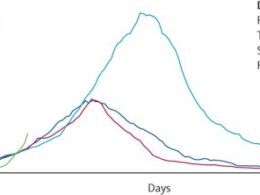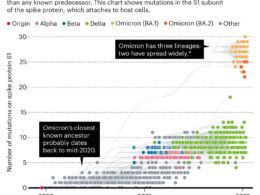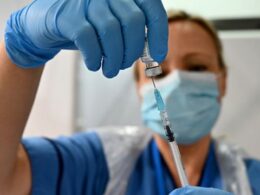How did the UK reach 200,000 Omicron infections in one day?
Scientists warn rates of coronavirus variant will continue to rise ‘like a rocket’
Financial Times
Oliver Barnes, John Burn-Murdoch and Sarah Neville in London
December 15, 2021
FT Montage/AFP/Getty
Health secretary Sajid Javid sent shockwaves through parliament on Monday when he revealed that an estimated 200,000 people in the UK had been infected with the Omicron coronavirus variant that day.
If Omicron infections continue to double every 2.5 days, as current estimates suggest, there will be a million people infected this coming Sunday alone.
Why are Omicron infection estimates so much higher than confirmed cases?
On Monday, when the UK Health Security Agency estimated around 200,000 new Omicron infections occurred, there were 59,610 confirmed cases of Covid-19, of which around 37,000 are estimated to have been Omicron. The daily caseload was the fifth highest recorded during the pandemic.
Yet the 200,000 figure, which is based on modelling by UKHSA, could be an underestimate, according to to health officials. “It’s ripping up like a rocket . . . close to everyone is going to get it,” said Carl Pearson, a research fellow in mathematical modelling at the London School of Hygiene and Tropical Medicine.
However, infections and cases are two separate metrics. Chris Jarvis, an assistant professor in biostatistics at the London School of Hygiene and Tropical Medicine, said a large proportion of infections are asymptomatic and would be largely missed by testing.
“Even if every single one of those 200,000 people did a test, which they won’t, they won’t arrive in our case data till the weekend at the earliest,” because of reporting lags, he said.
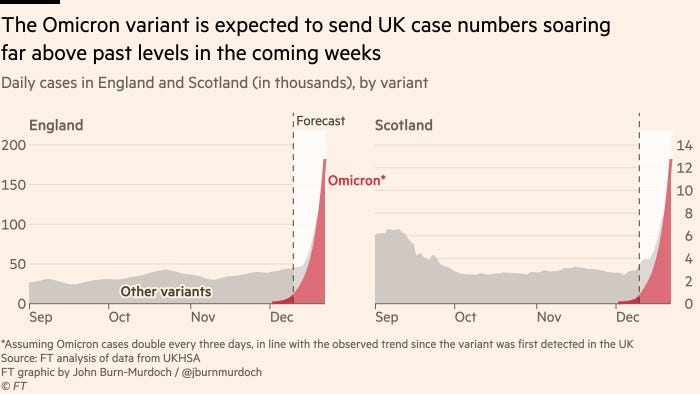
Prof Steven Riley, director-general of data and analytics at UKHSA, said that as infection rates rose further, testing capacity may affect how many infections are picked up in case data.
“The actual peak number of cases will probably revolve around peak testing capacity,” he told MPs at the science and technology select committee on Tuesday. In the week ending December 13, the average daily PCR testing capacity was just above 800,000 tests per day.
Which age groups and regions are driving Omicron infections?
Cases are currently rising fastest in London, where they have more than doubled in the past week and are now climbing at more than 10 per cent per day, effectively doubling every 6 days.
Next is the east of England, where daily case growth stands at 8 per cent, equivalent to one doubling every nine days.
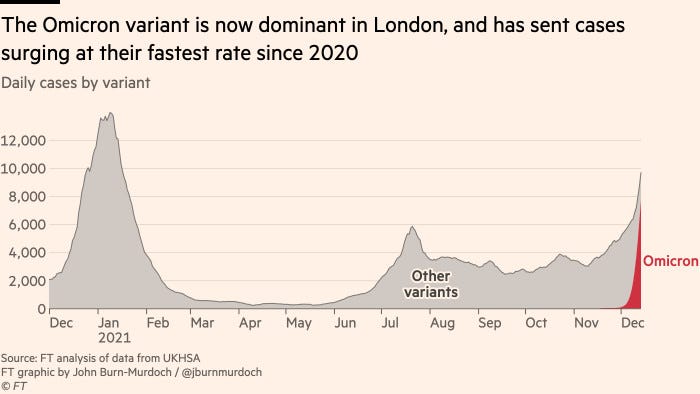
The two regions have the highest prevalence of Omicron in England and as the variant accounts for a larger share of cases in the coming days, these number of total cases is expected to rise.
Within London, growth in case numbers is being driven by young adults. Cases among people aged 20–34 are increasing by 15 per cent every day, with the number doubling in less than five days.
“London is much younger and so will have higher mixing rates, and travel from South Africa is probably going to come via London, so importations happened there first,” said Jarvis.
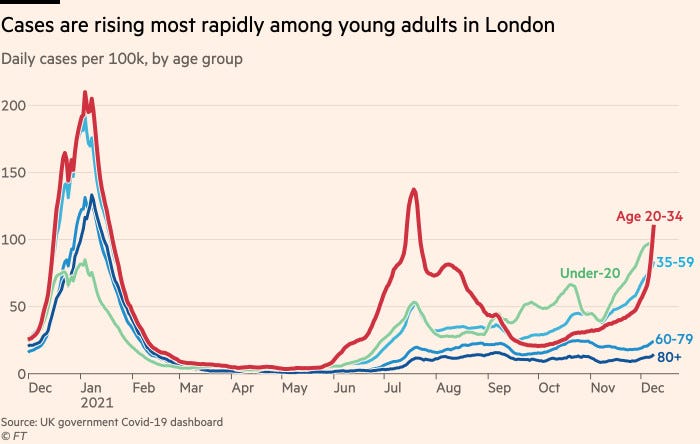
Will rapidly rising Omicron infections put pressure on hospitals?
Preliminary research from South Africa suggests the likelihood of an Omicron case ending up in hospital is lower than in earlier waves of Covid-19. Since November 15, the risk of a Covid-positive adult being admitted to hospital has been 29 per cent lower than during the first wave, according to a report from Discovery Health, South Africa’s largest private healthcare provider.
But if infections reach the numbers projected, even a small fraction of hospitalisations could still put massive pressure on the NHS.
“If we have a million infections a day, even a very small proportion of those individuals requiring hospitalisation will put significant impact on healthcare,” Susan Hopkins, chief medical adviser at UKHSA, told MPs on Tuesday.
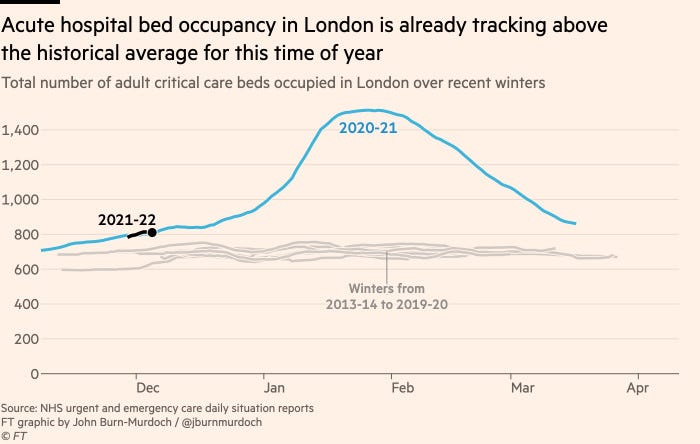
The latest modelling published by the London School of Hygiene and Tropical Medicine estimates daily admissions in England may peak at around 2,000 in mid January, just over half of last winter’s peak.
The UK government is banking on high vaccine booster coverage to restrain infection rates and has pledged to offer every eligible adult in England a third dose before the end of the year.
On Tuesday, the rule requiring a 15-minute observation period after the administration of the mRNA Covid vaccines from Pfizer/BioNTech and Moderna was suspended temporarily to “help the NHS get more jabs in arms more quickly to give people vital protection this winter”, Javid told MPs on Tuesday.
But Christina Pagel, professor of operational research at University College London, warned that while they can make a “big difference”, “boosters alone can’t catch up with and tame” fast-rising infections because immunity “takes about a week to kick in” and because 11.5m adults are “not yet eligible”.
“Omicron has been doubling every two days and even if that slows over the coming weeks, there is no doubt that we will see a large number of new infections over the next four weeks,” she said.
Prof Thomas House, a mathematical epidemiologist at Manchester University and member of SPI-M modelling group, said he “would not be surprised at all” if daily hospital admissions hit similar levels to the UK’s first and second waves. “For the average person, your personal risk is low,” he said. “The problem is that because it’s going to be a lot of us all at once, it’s going to have this societal effect.”
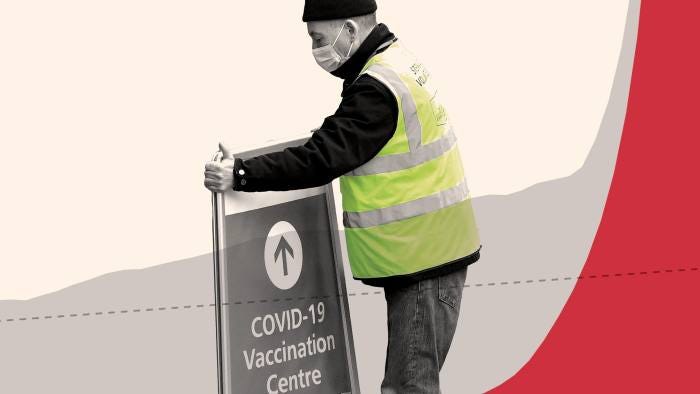
How high will the infection numbers go?
Hopkins said that over the three weeks that she and her colleagues had been monitoring the Omicron variant, its growth rate seemed “to be shortening, rather than lengthening”.
But experts stressed that eventually this growth rate will slow. “It has to slow eventually,” said Jarvis. He explained that fall-off in the growth rate would be “a function of what restrictions we have in place, how many people have been infected, how many people have been vaccinated and behaviour changes”.
Prime minister Boris Johnson has acknowledged there is a “huge spike coming”, but Downing Street maintains that the government’s current measures — including work from home orders, mask mandates and the accelerated booster programme — will be enough to combat Omicron’s spread.
Originally published at https://www.ft.com on December 14, 2021.






